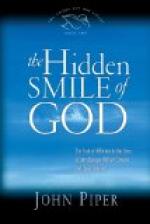Bunyan’s end was in keeping with his life. He had ever sought to be a peacemaker and to reconcile differences, and thus had “hindered many mishaps and saved many families from ruin.” His last effort of the kind caused his death. The father of a young man in whom he took an interest, had resolved, on some offence, real or supposed, to disinherit his son. The young man sought Bunyan’s mediation. Anxious to heal the breach, Bunyan mounted his horse and took the long journey to the father’s house at Reading—the scene, as we have noticed, of his occasional ministrations—where he pleaded the offender’s cause so effectually as to obtain a promise of forgiveness. Bunyan returned homewards through London, where he was appointed to preach at Mr. Gamman’s meeting-house near Whitechapel. His forty miles’ ride to London was through heavy driving rain. He was weary and drenched to the skin when he reached the house of his “very loving friend,” John Strudwick, grocer and chandler, at the sign of the Star, Holborn Bridge, at the foot of Snow Hill, and deacon of the Nonconformist meeting in Red Cross Street. A few months before Bunyan had suffered from the sweating sickness. The exposure caused a return of the malady, and though well enough to fulfil his pulpit engagement on Sunday, the 19th of August, on the following Tuesday dangerous symptoms declared themselves, and in ten days the disease proved fatal. He died within two months of completing his sixtieth year, on the 31st of August, 1688, just a month before the publication of the Declaration of the Prince of Orange opened a new era of civil and religious liberty, and between two and three months before the Prince’s landing in Torbay. He was buried in Mr. Strudwick’s newly-purchased vault, in what Southey has termed the Campo Santo of Nonconformists, the burial-ground in Finsbury, taking its name of Bunhill or Bonehill Field, from a vast mass of human remains removed to it from the charnel house of St. Paul’s Cathedral in 1549. At a later period it served as a place of interment for those who died in the Great Plague of 1665. The day after Bunyan’s funeral, his powerful friend, Sir John Shorter, the Lord Mayor, had a fatal fall from his horse in Smithfield, and “followed him across the river.”
By his first wife, whose Christian name is nowhere recorded, Bunyan had four children—two sons and two daughters; and by his second wife, the heroic Elizabeth, one son and one daughter. All of these survived him except his eldest daughter Mary, his tenderly-loved blind child, who died before him. His wife only survived him for a brief period, “following her faithful pilgrim from this world to the other whither he was gone before her” either in 1691 or 1692. Forgetful of the “deed of gift,” or ignorant of its bearing, Bunyan’s widow took out letters of administration of her late husband’s estate, which appears from the Register Book to have amounted to no more than, 42 pounds 19s. On this, and the proceeds of his books, she supported herself till she rejoined him.




